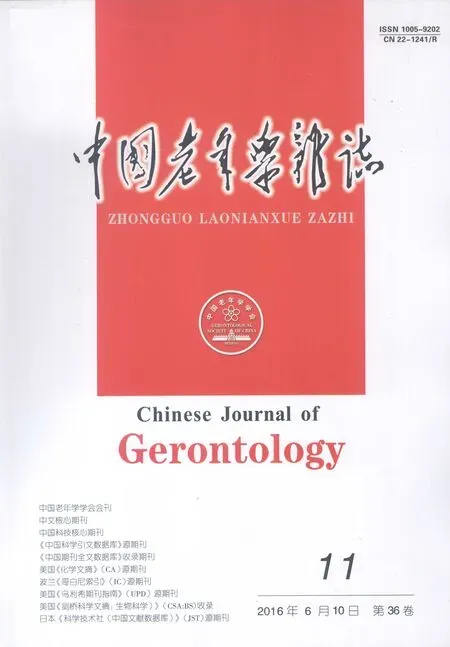脑梗死患者循环内皮祖细胞的研究进展
王万松 屈新辉 吴晓牧
(南昌大学医学院,江西 南昌 330006)
脑梗死患者循环内皮祖细胞的研究进展
王万松屈新辉1吴晓牧1
(南昌大学医学院,江西南昌330006)
〔关键词〕脑梗死;内皮祖细胞;血管再生
脑梗死是最常见的脑血管疾病,临床以相应神经功能缺损为主要表现。脑梗死病因较为明确,导致脑血管供血障碍,脑实质缺血坏死。病理上病灶中心坏死区和灶周脑缺血半暗带并存。挽救缺血半暗带、恢复神经元功能均以血管再通和修复为先决条件。脑梗死后内皮祖细胞(EPCs)的各项研究成为当前热点,并有可能为脑梗死的治疗和预后评估提供新思路。
1EPCs的特性和鉴定
EPCs最早由Asahara等〔1〕发现并提出,认为该类细胞能在生理或病理情况下维持血管功能,参与血管内皮修复和血管再生。EPCs主要来自骨髓,经缺血组织释放各种缺氧因子动员并释放入外周血,归巢至受损组织,参与血管修复〔2〕。其免疫表型动态变化与造血干细胞和内皮细胞有交叉〔3,4〕:CD34、CD133和血管内皮生长因子(VEGF)受体(R)2。CD34是一种高度糖基化Ⅰ型跨膜蛋白,在EPCs、造血干细胞和血管内皮细胞表面选择性表达。CD133是一种胆固醇结合糖基化跨膜多肽,在EPCs和造血干细胞表面选择性表达。VEGFR2即胎肝激酶(Flk)-1(鼠)或含激酶插入区受体(KDR)(人),血管系统最早出现的细胞标志,是胚胎期血液、血管发生的关键受体。在不同发育阶段EPCs表达着不同的免疫表型,目前认为:CD34+、 CD133+和VEGFR2+为早期EPCs,CD133+在细胞成熟过程中逐渐丢失,CD34+和VEGFR+为晚期EPCs。不同发育阶段EPCs呈现不同细胞形态,早期EPCs呈卵圆形、长梭形或纺锤形铺路石样,而晚期EPCs则呈血岛样结构。不同发育阶段EPCs拥有不同细胞功能,早期EPCs通过旁分泌作用,分泌VEGF参与血管修复和发生〔5〕,晚期EPCs则直接分化为内皮细胞〔6〕。
关于EPCs的鉴定存在争议,目前主要依据细胞形态和免疫表型鉴定。EPCs是从不成熟的造血细胞到接近成熟的内皮细胞这一过程中处于不同分化阶段的一群细胞〔7〕,EPCs细胞形态的动态变化造成形态学鉴定的不准确性。由于暂未发现EPCs表达特定的表面抗原,EPCs共表达造血干细胞和成熟内皮细胞表面抗原,EPCs的免疫表型可随时间和空间变化而发生变化〔8〕。仅通过表面抗原鉴定,易与上述两种细胞混淆。在一些研究中EPCs通过体外细胞培养鉴定,其优点在于可对细胞数量有效计数,能动态观察细胞的分化能力。但体外培养环境异于人体内环境,且细胞形态的动态变化和细胞免疫表型的可塑性,体外培养鉴定的准确性也有待评估。可见,目前仍然难以准确定义EPCs,主要是受限于缺乏特异的免疫表型和异于人体内环境的细胞培养,而限制EPCs进一步的研究。
2健康人体循环EPCs的数量差异
正常健康人体外周血中存在少量EPCs,并且随个体差异而数量不同。首先循环EPCs的数量随年龄的增长而减少〔9〕,Kushner等〔10〕证实年龄增长加速EPCs凋亡。其次,性别差异也导致其数量不同,年轻女性循环EPCs数量最多,这可能和雌激素水平变化相关〔11〕。亦有研究证实循环EPCs数量受生活方式影响,运动型生活方式能维持较高水平的EPCs数量〔12〕。并且循环EPCs数量受空气污染影响,研究认为空气污染能不断损害血管内皮消耗EPCs,从而导致循环EPCs数量处于较低水平〔13〕。对健康肥胖人群的研究发现其循环EPCs数量下降〔14〕,但具体机制不明。
3脑梗死后循环EPCs的数量变化
循环EPCs被认为可以反映机体内皮的修复能力,循环EPCs数量出现波动可反映血管修复再生的情况。Tsai等〔15〕发现急性脑梗死后第1天早期EPCs和晚期EPCs数量均显著降低,随后逐步增加,直至第30天恢复至正常水平,并且在大血管病变组尤为明显。Woywodt等〔16〕发现在急性腔隙性脑梗死和心源性脑栓塞后90 d之内循环EPCs皆处于低水平状态,而在动脉粥样硬化性血栓型脑梗死病程中,循环EPCs数量显著增高,并在病程第7天达最高水平。然而在其他研究中则得出相反结论,Navarro-Sobrino等〔17〕发现在脑梗死发作3~24 h外周血EPCs数量上升,并认为这是急性动员所致。Paczkowska等〔18〕研究发现在脑梗死后1~7 d外周血早期EPCs和晚期EPCs数量都明显上升,并且早期EPCs数量在第3天达到高峰,并认为VEGF的分泌是动员因素之一。虽然脑梗死后循环EPCs数量变化存在争议,但多数研究结果都支持低水平的循环EPCs提示预后不良〔19〕。这可能是由于大面积血管修复消耗了大量EPCs,大量炎症因子抑制EPCs动员及促进外周血中EPCs凋亡所导致的循环EPCs减少〔20〕。
目前研究结果虽然互相补充,有些可能片面,而且有些似乎相互矛盾,原因主要有:①采用不同的EPCs鉴定方法,检测不同的免疫表型,所反映的是不同EPCs亚型的数量变化。②检测不同类型的脑梗死,不同的病理生理机制导致不同的EPCs数量变化。③检测时间点的差异,EPCs处于动态变化状态,不同时间点EPCs数量不一。④正常对照组设定不同,由于EPCs在不同性别不同年龄段的数量不同,导致了不同的EPCs数量变化。⑤不同脑梗死危险因素及相应的药物治疗影响循环EPCs的数量波动。
4脑梗死危险因素与循环EPCs的数量和功能
常见脑梗死危险因素有高脂血症、高血压、糖尿病、吸烟和动脉粥样硬化等。这些常见危险因素皆导致循环EPCs数量减少和功能下降。但是其具体机制目前尚未明确。最新研究认为可能是通过减少EPCs形成、抑制EPCs动员、消耗循环EPCs、促进EPCs凋亡来减少其数量;并可通过影响EPCs迁徙、分泌和分化来减弱其功能。
在高脂血症中,脂蛋白的紊乱,尤其是高密度脂蛋白降低和低密度脂蛋白升高都能导致循环EPCs数量的减少〔21〕,并可影响EPCs的分化能力,致使功能减退〔22〕。Tie等〔23〕发现氧化低密度脂蛋白抑制磷脂酰肌醇激酶(PI3K)/丝氨酸-苏氨酸激酶(Akt)信号通路导致EPCs凋亡的发生。
在高血压中,肾素-血管张素-醛固醇系统(RAAS)紊乱导致醛固酮增多,抑制EPCs表面标志物之一VEGFR的形成,从而减少EPCs的生成〔24〕。另有研究发现高血压促进循环EPCs降钙素基因相关肽的表达下调,并认为该因子表达的下调与循环EPCs的抗氧化能力减弱相关,并导致EPCs早衰〔25〕。而长期高血压患者电压门控性氯离子通道(CLC)-3开放数量持续上调,并增加细胞内活性氧(ROS)的产生,激活还原型烟酰胺腺嘌噙二核苷酸磷酸(NADPH)氧化酶,从而促进循环EPCs的凋亡〔25〕。糖尿病所致的高血糖微环境可改变骨髓EPCs免疫表型的形成,减少骨髓中EPCs生成〔26〕。而且高血糖还可损害EPCs的成熟,致使晚期EPCs数量减少〔27〕。Saito 等〔28〕发现糖尿病患者骨髓和外周血中EPCs亚型改变和数量减少。Li等〔29〕研究表明晚期糖基化终末产物损害EPCs迁徙、黏附和分泌功能。
吸烟能导致氧化与抗氧化失衡和炎症反应失衡减少EPCs的数量〔30〕,尤其是吸烟损害全身血管内皮细胞,不断消耗外周循环血中的EPCs,并可减少早期EPCs的数量和黏附功能〔31〕。
而在动脉粥样硬化中,虽然其病因不明并且危险因素众多,但是都使EPCs处于炎症状态。Vemparala等〔32〕发现动脉粥样硬化可加速EPCs衰老,使EPCs存活时间缩短,并可以影响EPCs分化能力,致使功能减退。
上述危险因素都能打破血管内皮损害和修复平衡,加大循环EPCs消耗。而且它们的病理生理机制相互关联,常共同发病,可能通过多重机制影响循环EPCs数量和功能。虽然有较多研究阐述脑梗死危险因素与EPCs数量和功能的相关性,但其具体机制仍有待进一步研究。
5现行研究的局限与不足
虽然大量实验研究指出脑梗死后EPCs参与修复并存在复杂动态的数量变化,但是仍存在较多的局限性和不足。主要为:①缺乏公认的特异表型,现行的表面抗原鉴定标准和造血细胞、内皮细胞有交叉重叠,导致无法确切鉴定EPCs。②对EPCs及各亚型的功能不甚明了,尚未明确EPCs的生成、动员、迁徙和修复机制。③几乎在所有实验中都未能检测EPCs的功能。④EPCs与不同类型的脑梗死之间的联系未能阐明。
6展望
能否应用EPCs治疗脑梗死和独立预测脑梗死的预后成为当前热点。在治疗方面,是否可以减少梗死面积、减轻病灶周围水肿、具体的治疗时间窗、不同亚型EPCs的选择等成为当前研究方向。虽然有学者证实了其有效性〔33〕,但是关于其具体机制、作用的持久性、毒副作用和不良反应仍有待进一步的研究。在预测预后方面,脑梗死后EPCs的数量变化和预后的相关性及数量与脑梗死严重程度相关性成为研究重点。脑梗死后EPCs数量的增减、持续时间、不同亚型数量变化差异、与神经功能缺损评分相关性都存在争议。但是这些问题的解决都有赖于EPCs的确切定义和具体修复机制的深入研究。
7参考文献
1Asahara T,Murohara T,Sullivan A,etal.Isolation of putative progenitor endothelial cells for angiogenesis 〔J〕.Science,1997;275(5302):964-6.
2Shen L,Gao Y,Qian J,etal.A novel mechanism for endothelial progenitor cells homing:the SDF-1/CXCR4-Rac pathway may regulate endothelial progenitor cells homing through cellular polarization 〔J〕.Med Hypotheses,2011;76(2):256-8.
3Peichev M,Naiyer AJ,Pereira D,etal.Expression of VEGFR-2 and AC133 by circulating human CD34+cells identifies a population of functional endothelial precursors 〔J〕.Blood,2000;95(3):952-8.
4Masuda H,Alev C,Akimaru H,etal.Methodological development of a clonogenic assay to determine endothelial progenitor cell potential〔J〕.Circ Res,2011;109(1):20-37.
5Medina RJ,O′Neill CL,O′Doherty TM,etal.Myeloid angiogenic cells act as alternative M2 macrophages and modulate angiogenesis through interleukin-8 〔J〕.Mol Med,2011;17(9-10):1045-55.
6Medina RJ,O′Neill CL,Sweeney M,etal.Molecular analysis of endothelial progenitor cell(EPC)subtypes reveals two distinct cell populations with different identities 〔J〕.BMC Med Genomics,2010;3:18.
7Dome B,Timar J,Ladanyi A,etal.Circulating endothelial cells,bone marrow-derived endothelial progenitor cells and proangiogenic hematopoietic cells in cancer:from biology to therapy〔J〕.Crit Rev Oncol Hematol,2009;69(2):108-24.
8Masouleh BK,Baraniskin A,Schmiegel W,etal.Quantification of circulating endothelial progenitor cells in human peripheral blood:establishing a reliable flow cytometry protocol 〔J〕.J Immunol Meth,2010;357(1-2):38-42.
9Jie KE,Goossens MH,van Oostrom O,etal.Circulating endothelial progenitor cell levels are higher during childhood than in adult life 〔J〕.Atherosclerosis,2009;202(2):345-7.
10Kushner EJ,MacEneaney OJ,Weil BR,etal.Aging is associated with a proapoptotic endothelial progenitor cell phenotype 〔J〕.J Vasc Res,2011;48(5):408-14.
11Rousseau A,Ayoubi F,Deveaux C,etal.Impact of age and gender interaction on circulating endothelial progenitor cells in healthy subjects 〔J〕.Fertil Steril,2010;93(3):843-6.
12Yang Z,Xia WH,Su C,etal.Regular exercise-induced increased number and activity of circulating endothelial progenitor cells attenuates age-related decline in arterial elasticity in healthy men 〔J〕.Int J Cardiol,2013;165(2):247-54.
13O′Toole TE,Hellmann J,Wheat L,etal.Episodic exposure to fine particulate air pollution decreases circulating levels of endothelial progenitor cells 〔J〕.Circ Res,2010;107(2):200-3.
14Tsai TH,Chai HT,Sun CK,etal.Obesity suppresses circulating level and function of endothelial progenitor cells and heart function 〔J〕.J Transl Med,2012;10:137.
15Tsai NW,Hung SH,Huang CR,etal.The association between circulating endothelial progenitor cells and outcome in different subtypes of acute ischemic stroke 〔J〕.Clin Chim Acta,2014;427:6-10.
16Woywodt A,Gerdes S,Ahl B,etal.Circulating endothelial cells and stroke:influence of stroke subtypes and changes during the course of disease 〔J〕.J Stroke Cerebrovasc Dis,2012;21(6):452-8.
17Navarro-Sobrino M,Rosell A,Hernandez-Guillamon M,etal.Mobilization,endothelial differentiation and functional capacity of endothelial progenitor cells after ischemic stroke 〔J〕.Microvasc Res,2010;80(3):317-23.
18Paczkowska E,Golab-Janowska M,Bajer-Czajkowska A,etal.Increased circulating endothelial progenitor cells in patients with haemorrhagic and ischaemic stroke:the role of endothelin-1 〔J〕.J Neurol Sci,2013;325(1-2):90-9.
19Bogoslovsky T,Chaudhry A,Latour L,etal.Endothelial progenitor cells correlate with lesion volume and growth in acute stroke 〔J〕.Neurology,2010;75(23):2059-62.
20Chen J,Jin J,Song M,etal.C-reactive protein down-regulates endothelial nitric oxide synthase expression and promotes apoptosis in endothelial progenitor cells through receptor for advanced glycation end-products 〔J〕.Gene,2012;496(2):128-35.
21Rossi F,Bertone C,Montanile F,etal.HDL cholesterol is a strong determinant of endothelial progenitor cells in hypercholesterolemic subjects 〔J〕.Microvasc Res,2010;80(2):274-9.
22Zhang X,Mao H,Chen JY,etal.Increased expression of microRNA-221 inhibits PAK1 in endothelial progenitor cells and impairs its function via c-Raf/MEK/ERK pathway 〔J〕.Biochem Biophys Res Commun,2013;431(3):404-8.
23Tie G,Yan J,Yang Y,etal.Oxidized low-density lipoprotein induces apoptosis in endothelial progenitor cells by inactivating the phosphoinositide 3-kinase/Akt pathway 〔J〕.J Vasc Res,2010;47(6):519-30.
24Ladage D,Schutzeberg N,Dartsch T,etal.Hyperaldosteronism is associated with a decrease in number and altered growth factor expression of endothelial progenitor cells in rats 〔J〕.Int J Cardiol,2011;149(2):152-6.
25Zhou Z,Peng J,Wang CJ,etal.Accelerated senescence of endothelial progenitor cells in hypertension is related to the reduction of calcitonin gene-related peptide 〔J〕.J Hypertens,2010;28(5):931-9.
26Loomans CJ,van Haperen R,Duijs JM,etal.Differentiation of bone marrow-derived endothelial progenitor cells is shifted into a proinflammatory phenotype by hyperglycemia 〔J〕.Mol Med,2009;15(5-6):152-9.
27Lombardo MF,Iacopino P,Cuzzola M,etal.Type 2 diabetes mellitus impairs the maturation of endothelial progenitor cells and increases the number of circulating endothelial cells in peripheral blood 〔J〕.Cytometry A,2012;81(10):856-64.
28Saito H,Yamamoto Y,Yamamoto H.Diabetes alters subsets of endothelial progenitor cells that reside in blood,bone marrow,and spleen 〔J〕.Am J Physiol Cell Physiol,2012;302(6):C892-901.
29Li H,Zhang X,Guan X,etal.Advanced glycation end products impair the migration,adhesion and secretion potentials of late endothelial progenitor cells 〔J〕.Cardiovasc Diabetol,2012;11(5):1-10.
30Mandraffino G,Sardo MA,Riggio S,etal.Smoke exposure and circulating progenitor cells:evidence for modulation of antioxidant enzymes and cell count 〔J〕.Clin Biochem,2010;43(18):1436-42.
31Puls M,Schroeter MR,Steier J,etal.Effect of smoking cessation on the number and adhesive properties of early outgrowth endothelial progenitor cells 〔J〕.Int J Cardiol,2011;152(1):61-9.
32Vemparala K,Roy A,Bahl VK,etal.Early accelerated senescence of circulating endothelial progenitor cells in premature coronary artery disease patients in a developing country-a case control study 〔J〕.BMC Cardiovasc Disord,2013;13(13):104.
33Nakamura K,Tsurushima H,Marushima A,etal.A subpopulation of endothelial progenitor cells with low aldehyde dehydrogenase activity attenuates acute ischemic brain injury in rats 〔J〕.Biochem Biophys Res Commun,2012;418(1):87-92.
〔2015-03-07修回〕
(编辑王一涵)
基金项目:江西省卫生厅科技计划项目(No.20133013)
通讯作者:屈新辉(1970-),男,硕士,主任医师,硕士生导师,主要从事脑血管病和神经康复研究。
〔中图分类号〕R743
〔文献标识码〕A
〔文章编号〕1005-9202(2016)11-2819-03;
doi:10.3969/j.issn.1005-9202.2016.11.117
1江西省人民医院神经内科江西省神经病学研究所
第一作者:王万松(1988-),男,硕士,主要从事神经康复研究。

